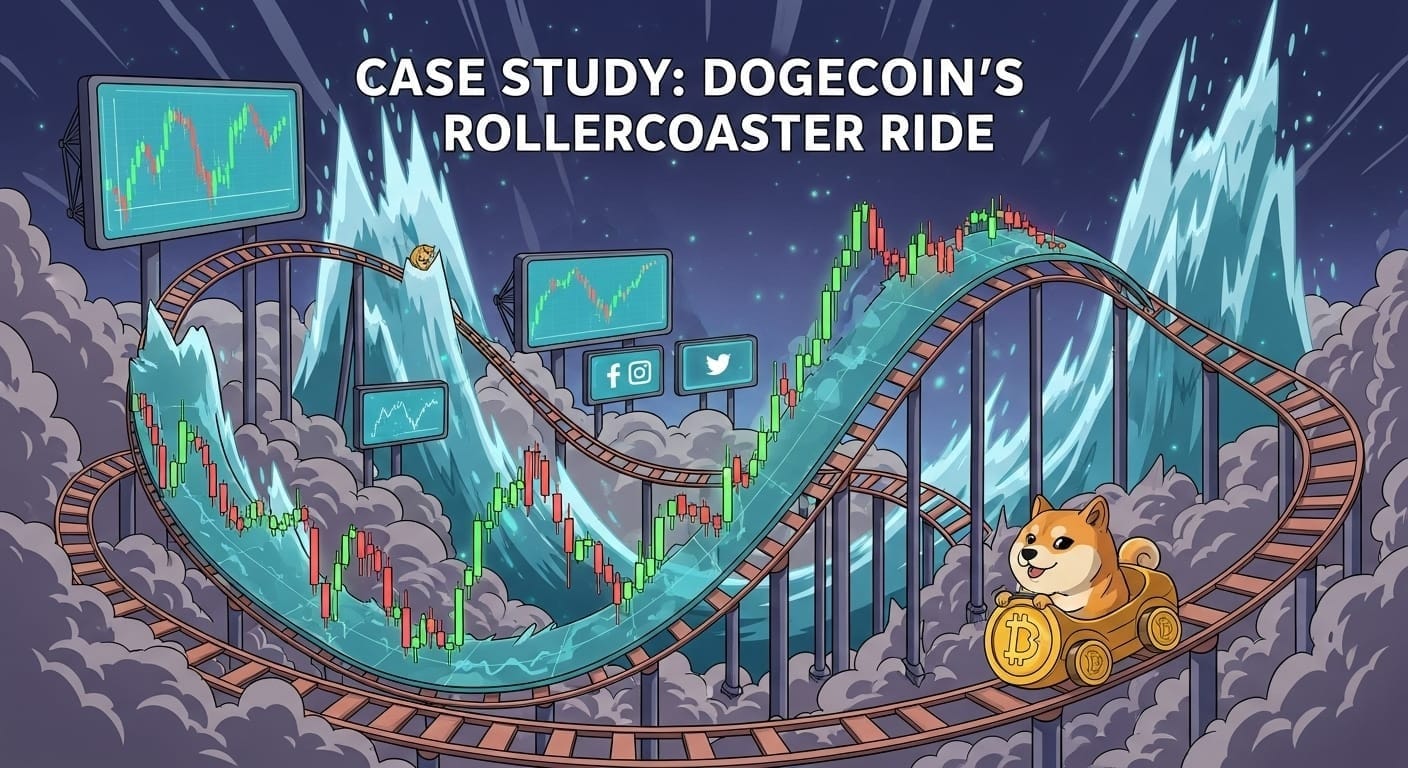Introduction: A Cryptocurrency Conundrum
Imagine a cryptocurrency where the total market value surges, yet each coin’s price plummets. This paradox defines inflationary cryptocurrencies in 2025, captivating investors navigating the blockchain landscape. Unlike Bitcoin’s fixed supply, these assets feature continuous coin issuance, blending opportunity with complexity.
Why does this divergence occur, and how can investors thrive? This article explores the mechanics of inflationary cryptocurrencies, offering clear insights and strategies for success. Whether you’re a crypto enthusiast or a seasoned trader, mastering these dynamics is essential in today’s volatile digital economy.
What Are Inflationary Cryptocurrencies?
Inflationary cryptocurrencies are digital assets with a supply that grows over time, unlike deflationary assets like Bitcoin. New coins enter circulation through mining rewards, staking incentives, or scheduled token releases. Examples like Dogecoin illustrate how this model drives network activity while posing economic challenges.

Explore a deeper understanding of how meme coins sometimes operate.
Key Features of Inflationary Cryptocurrencies
- Continuous Coin Issuance: New coins are minted regularly, expanding supply and shaping market dynamics.
- Network Incentives: Rewards for mining or staking boost user participation and blockchain security.
- Economic Trade-Offs: Rapid supply growth can dilute coin value if demand lags, impacting price stability.
Source: Cryptocurrency Supply Models Explained, Investopedia
Why Inflationary Cryptocurrencies Matter in 2025
In the 2025 blockchain ecosystem, inflationary cryptocurrencies offer diversification beyond fixed-supply assets. With decentralized finance (DeFi) and Web3 reshaping markets, these assets play a vital role. Dogecoin’s community-driven growth exemplifies their impact, fueling adoption despite price volatility. Understanding supply-driven models is key as global crypto adoption accelerates.

Case Study: Dogecoin’s Rollercoaster Ride
Launched in 2013 as a playful meme coin, Dogecoin exemplifies the dynamics of an inflationary cryptocurrency model. It issues a fixed reward of 10,000 coins per block, with new blocks generated approximately every minute, leading to an annual supply increase of exactly 5.256 billion coins.
Dogecoin’s market capitalization soared to over $88.8 billion in May 2021, fueled by viral social media momentum and high-profile endorsements, notably from Elon Musk. Throughout 2024, sustained community-driven campaigns and growing merchant adoption helped maintain Dogecoin’s prominence, even as price volatility persisted, largely influenced by its continuous supply expansion.
Navigating the Inflationary Crypto Landscape
Investors in inflationary cryptocurrencies should track supply schedules, network activity, and market sentiment. Tools like Glassnode or Dune Analytics offer real-time data on issuance and holder behavior. Engaging on platforms like X with #CryptoTrends2025 can reveal emerging trends.

Understanding Technical Indicators
Source: Mastering Crypto Market Analysis, Blockchain Council, February 2025
Practical Tips for Investors
- Track Supply Schedules: Monitor coin issuance to anticipate price impacts.
- Analyze Network Activity: High transaction volumes signal strong adoption.
- Stay Engaged: Join X discussions to stay updated on market sentiment.
The Economics of Inflation in Cryptocurrencies
In traditional economics, inflation reduces purchasing power as money supply grows. In cryptocurrencies, new coins outpacing demand depress prices, amplified by speculative trading and volatile sentiment in crypto markets.
Supply vs. Demand: The Core Challenge
When coin issuance exceeds demand, prices decline, even as networks grow. Effective projects balance this through strategic mechanisms, ensuring demand keeps pace with supply.
Why Market Caps Rise as Prices Fall
Market capitalization (coin price × circulating supply) measures a cryptocurrency’s total value.
An expanding supply can inflate market cap even as coin prices drop due to:
- Supply Growth: New coins boost market cap, despite falling per-coin value.
- Speculative Buying: Investor enthusiasm temporarily elevates market cap.
- Network Expansion: Adoption drives market cap, but rapid issuance suppresses prices.
- Market Manipulation: Large holders (“whales”) may inflate metrics via trades.
Source: Decoding Crypto Market Cap, CoinDesk.
Case Study: Stellar’s Controlled Inflation
Stellar (XLM), which had an inflation mechanism until 2019 when it was removed following a community vote, shifting to a different supply model. In 2024, its focus on cross-border payments boosted adoption, stabilizing its market cap despite past inflationary pressures. This highlights the role of governance in managing supply (Stellar’s Role in Payments, Stellar Development Foundation, June 2024).
Pending user confirmation: A graph comparing Stellar’s market cap and price trends from 2023 to 2025 could illustrate governance impacts.

Understanding Consensus
Challenges of Inflationary Models
Continuous supply growth risks diluting holdings and increasing volatility, eroding investor confidence and deterring long-term investment.
Key Investor Impacts
- Dilution Risk: New coins reduce existing holdings’ value.
- Price Volatility: Rapid issuance fuels market fluctuations.
- Perception Challenges: Persistent inflation may signal instability.

A Guide to Crypto Trading Strategies
Strategies to Counter Inflationary Pressures
Successful projects use mechanisms to manage supply:
- Token Burning: Destroying coins, as in Binance Coin, reduces supply.
- Capped Issuance: Gradual reductions, like Ethereum’s post-2022 model, stabilize growth.
- Staking Rewards: Incentives, as in Cardano, encourage holding.
Source: Token Burning Explained, CoinTelegraph, September 2024

The Power of Market Sentiment in 2025
Market sentiment shapes cryptocurrency performance. Positive developments, like technological upgrades or partnerships, boost demand, offsetting inflation. Negative news, such as regulatory shifts, can amplify price declines. In 2025, global crypto adoption heightens sentiment’s impact.

Paul Snow Talks About Societal Impact
Social Media’s Role
Platforms like X drive sentiment through campaigns and influencer endorsements. Engaging with these communities boosts project visibility.
Call to Action: Share your thoughts on inflationary cryptocurrencies. Which projects balance supply and demand? Join the #CryptoTrends2025 conversation on X.

Are Inflationary Cryptocurrencies Sustainable?
Sustainability depends on aligning supply with demand. Projects with strong ecosystems, real-world utility, and transparent governance thrive. Ethereum’s shift to a model that can be deflationary under certain conditions post-2022, following the Merge and EIP-1559. This shows how adaptability enhances stability
Source: Ethereum Supply Dynamics, OKX
Keys to Long-Term Success
- Community Strength: Engaged communities drive adoption.
- Practical Utility: Applications in DeFi or payments enhance value.
- Innovative Governance: Transparent supply management builds trust.
Source: The Future of Blockchain in 2025, Blockchain Council.
The 2025 Crypto Landscape
In 2025, inflationary cryptocurrencies evolve with trends like DAO governance and regulatory clarity. The EU’s MiCA regulation and potential U.S. crypto-friendly policies, shape markets, boosting investor confidence
Source: Crypto Regulations in 2025, CoinDesk
Anticipated 2025 Trends
- DAO Governance: Community-driven supply management grows, as seen in projects like MakerDAO
- Source: DAO Guide for 2025, Nadcab
- Regulatory Clarity: EU’s MiCA and U.S. policies stabilize markets
- Source: The 2025 Crypto Policy Landscape, Atlantic Council
- Hybrid Models: Projects blend supply strategies for stability.
Conclusion: Mastering the Inflationary Crypto Paradox
Inflationary cryptocurrencies, with soaring market caps and volatile prices, reflect the complexities of the 2025 crypto landscape. By understanding supply-demand dynamics, leveraging mitigation strategies, and tracking sentiment, investors can unlock opportunities. Explore projects like Dogecoin or Stellar on Binance or Coinbase, and stay informed via CoinDesk. Join the #CryptoTrends2025 conversation on X to shape the future of digital finance.

Understanding Cryptocurrency and Blockchain Technologies
Frequently Asked Questions
What defines an inflationary cryptocurrency?
A digital asset with growing supply via mining, staking, or token releases, unlike Bitcoin’s fixed supply.
Why do prices drop while market caps rise?
Supply growth outpaces demand, reducing prices, while issuance or speculation boosts market cap.
How can inflationary cryptocurrencies maintain value?
Token burning, capped issuance, and staking incentives balance supply and demand.
Are these assets a smart investment in 2025?
Potential depends on fundamentals and market conditions. Research using CoinDesk or Investopedia.
How does sentiment impact these cryptocurrencies?
Positive sentiment drives demand, offsetting inflation; negative sentiment amplifies declines.
References
- Cryptocurrency Supply Models Explained, Investopedia
- Dogecoin’s 2024 Surge, CoinDesk
- Mastering Crypto Market Analysis, Blockchain Council
- Crypto Economics 101, Investopedia
- Decoding Crypto Market Cap, CoinDesk
- Stellar’s Role in Payments, Stellar Development Foundation
- Token Burning Explained, CoinTelegraph
- Ethereum Supply Dynamics, OKX
- The Future of Blockchain in 2025, Blockchain Council
- Crypto Regulations in 2025, CoinDesk
- DAO Guide for 2025, Nadcab



















Discussion